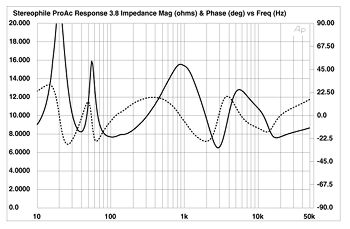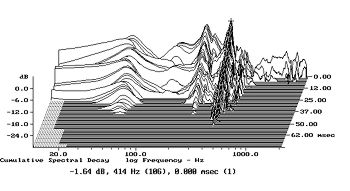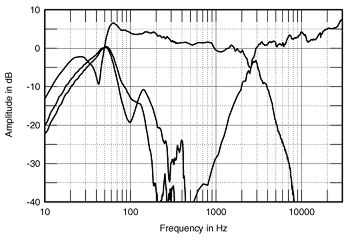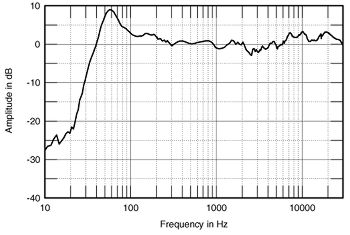| Columns Retired Columns & Blogs |
ProAc Response 3.8 loudspeaker Measurements
Sidebar 3: Measurements
Larry Greenhill observed that the ProAc 3.8 didn't sound as sensitive as he was expecting from its 88dB sensitivity specification and my own (B-weighted) estimate of 84.5dB/2.83V/m. While this is below average, the 3.8's impedance plot (fig.1) revealed it to be an easy load for the partnering amplifier to drive. The amplitude drops below 8 ohms only briefly in the upper bass and mid-treble, and the electrical phase angle is also low.

Fig.1 ProAc Response 3.8, electrical impedance (solid) and phase (dashed). (2 ohms/vertical div.)
Note, however, the slight discontinuity in the impedance traces in the 150Hz region, which implies the existence of some kind of cabinet resonance. Investigating the panel's vibrational behavior with a simple accelerometer revealed that what resonant modes did exist (fig.2) were high enough in frequency to have only minimal subjective consequences.

Fig.2 ProAc Response 3.8, cumulative spectral-decay plot of accelerometer output fastened to side wall. (MLS driving voltage to speaker, 7.55V; measurement bandwidth, 2kHz.)
However, the upper of the two ports did have a peak in its output at this frequency (fig.3), so it is probable that this correlates with the slight impedance anomaly. Fig.3 also shows that the lower port is better behaved in this respect, and that the twin woofers peak quite sharply in the 50Hz region. Not shown in this graph is the fact that, whereas the upper woofer extends out to the upper crossover point, the lower woofer starts to roll off above 300Hz, being 6dB down an octave higher. This gives a bass alignment that gently slopes down with increasing frequency.

Fig.3 ProAc Response 3.8, acoustic crossover on tweeter axis, corrected for microphone response, with sum of nearfield woofer and upper and lower port responses plotted below 400Hz.
To the right of fig.3 are shown the upper-frequency responses of the upper midwoofer and the tweeter. The crossover appears to be set at 2.5kHz, with symmetrical acoustic slopes. The tweeter has a gently rising on-axis response all the way to 30kHz, but it is very directional above 15kHz. This results in a more or less flat response when averaged across a 30 degrees horizontal window (fig.4). In fact, the ProAc's midrange and treble regions are both quite flat; only an excess of midbass energy—this resulting from the coincidence of the woofers' and ports' outputs in the 50Hz region—breaks the speaker's otherwise excellent measured performance. But it is likely that careful positioning in the listening room can compensate for this bass behavior.

Fig.4 ProAc Response 3.8, anechoic response on upper-midrange tweeter axis at 50", averaged across 30 degrees horizontal window and corrected for microphone response, with the complex sum of the nearfield woofer and port responses plotted below 400Hz.
- Log in or register to post comments




































